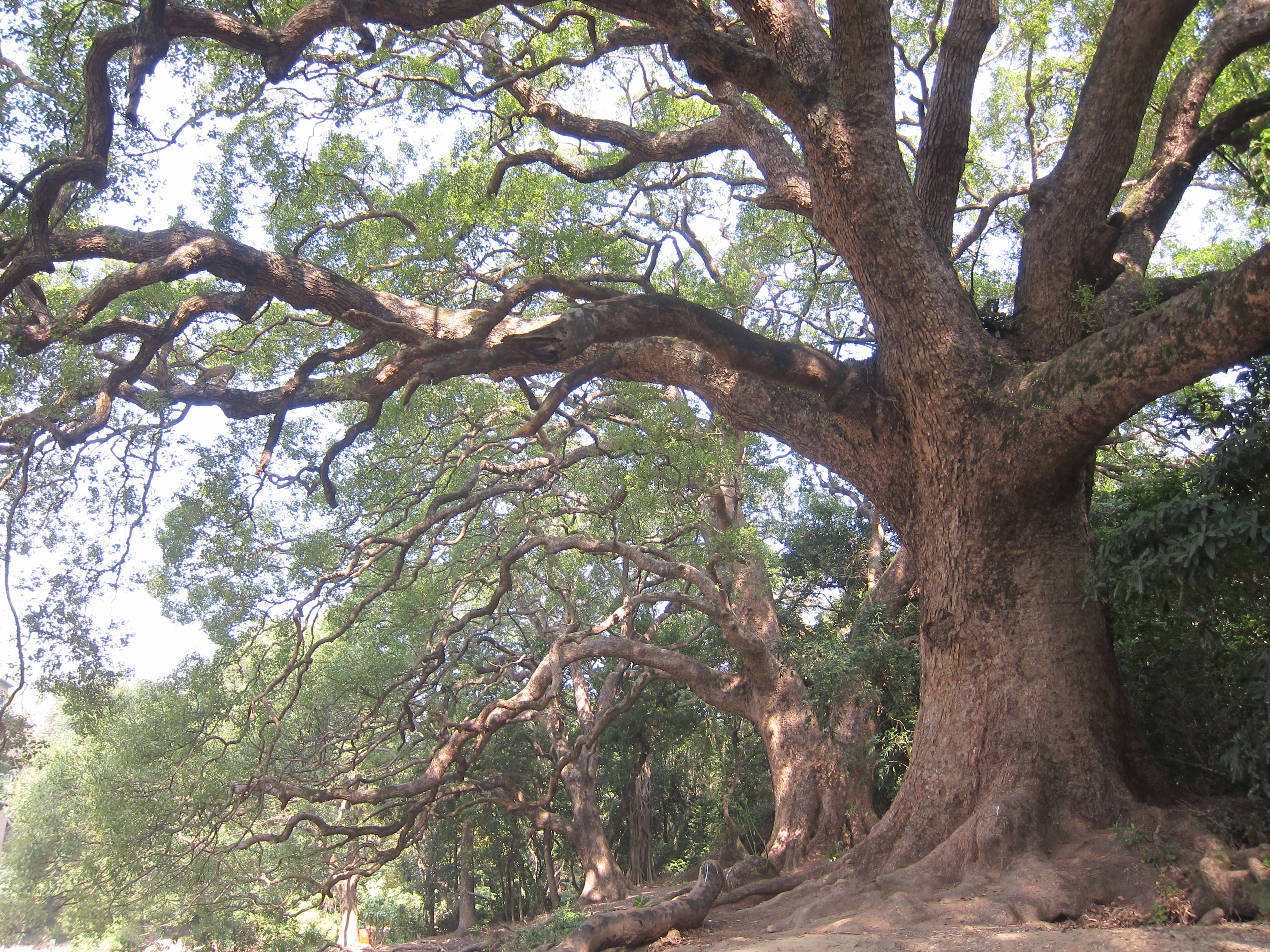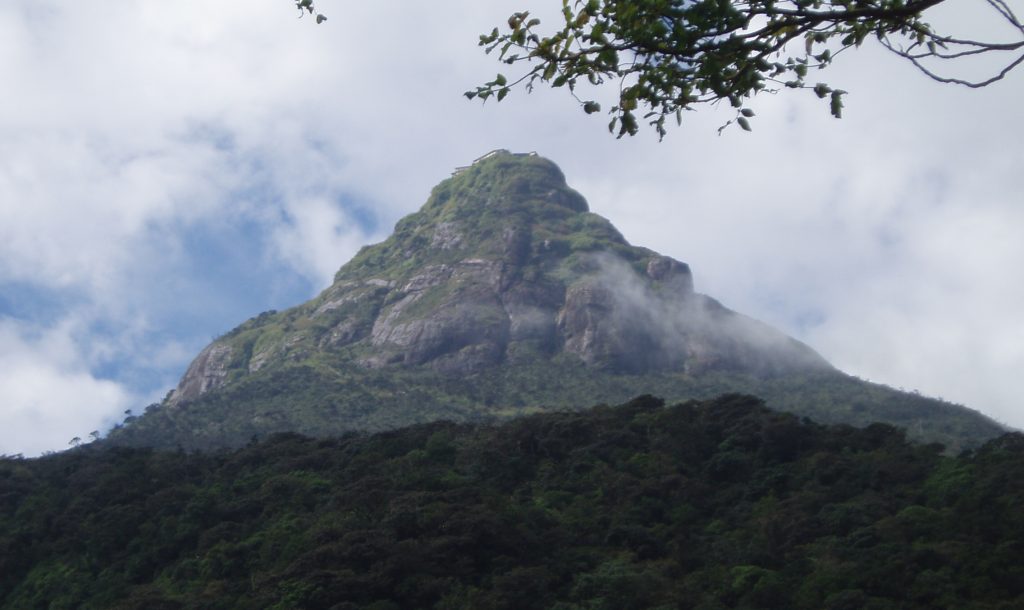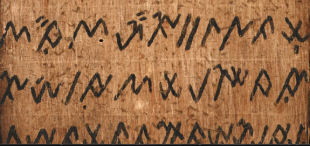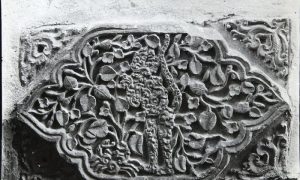In part one of this article, I introduced the 16th century Malay poet, Hamzah of Barus. I discussed how his renowned syair lyrical poems belonged to the same Sufi traditions of Rūmī, but how they are also heavily informed by the particularities of Southeast Asian Islam. I also gave an example of one of his poems in the original Malay and in English translation. In this second part of the article, I give a commentary on the stanzas of this poem, showing how the tale of the peculiar whale fits into Sufi ways of thinking and to the Indian Ocean world of the 16th century.
| ‘Ajab sekali akan gajahmina Tempatnya dā’im di laut Cina Mencari air ke Ṭūr Sīnā Olehnya itu kerjanya hina |
The whale is so peculiar! Its place is in the China sea, And yet it looks for water on Mount Sinai – a wretched task. |
In the opening stanza, the whale is introduced as a creature whose behaviour does not make sense. Despite living in the China sea, it goes to the trouble of looking for water on a Middle Eastern mountain. Hamzah takes the conventional Sufi image of the sea, which represents divine being, and adapts it to a specifically Southeast Asian context. The reference to Mount Sinai alludes to the story of Moses’ encounter with God, which appears in the Torah, the Bible, and the Qur’ān. The whale’s search for water on Mount Sinai is “wretched” (hina) because it is literally absurd: the mountain is in a desert, which the marine animal cannot reach. This is an allegorical way of saying that there is no point in trying to encounter God in the phenomenal world, because all beings are already partake of unity with God.
| Laut Cina terlalu dalam Itulah bangsa sekalian ‘ālam Merupakan jān malak dan Ādam Di laut itu kita nin karam |
The China sea is so profound That all varieties of beings, Including humans, angels, jinns, We all are shipwrecked in that sea. |
| Karangnya banyak rantaunya panjang Teluknya permai seperti kandang Ke laut itu yogya berenang Mangkanya dapat segera memandang |
With many reefs and lengthy coasts, Cute little coves like chicken coops, That sea is where you have to swim, So you can have true sight at last. |
| Ṭawfānnya dā’im terlalu nyala Datangnya sangat tiada berkala Menyelam ke sana sepala-pala Supaya dapat engkau berpahala |
Its typhoons flash incessantly, They can arrive at any time. Submerge yourself there, head to toe, And you will get your just reward. |
The sea as a metaphor of divine being is further developed in the second, third, and fourth stanzas, which specifically set the scene in maritime Southeast Asia. The poem emphasises how all of Creation experiences unity with God; in symbolic terms, the China sea is deep enough to contain all the angels, jinns, and humans that exist. Hamzah alludes to the hazards of shipwrecks and typhoons that, in his time, were a regular threat to the commercial communities of Southeast Asia. These communities were among the first to adopt and proliferate Islam in the region. Drowning is a common Sufi symbol for mystical union, which substitutes literal physical death (mawt) for figurative ego-death (fanā’). This ego-death leads to the “just reward” that is the recognition of one’s essential unity with God.
View of Adam’s Peak, Sri Lanka (Photo: Bourgeois)
| Ādam sūfī diharu shayṭān Di dalam surga berbunga rayḥān Datang ke dunya ke bukit Sailan Mabuk akan Hawa terlalu ḥayrān |
Adam, tormented by the Beast, When paradise was in full bloom, Fell down on a Sri Lankan hill, Confused and fully drunk on Eve. |
The fifth stanza changes the subject rather abruptly, by quoting an Indian Ocean legend of the expulsion of Adam and Eve from the Garden of Eden. According to this account, after God expelled Adam from paradise, he fell to earth and landed on what is now called Adam’s Peak, a tall conical mountain in southern Sri Lanka. On the summit of Adam’s Peak is a rock formation that resembles a footprint, which has been venerated for up to two thousand years by Buddhists as the Buddha’s footprint, by Christians as a mark of St. Thomas, and by Muslims as the footprint of Adam. This remarkable sacred site has drawn the attention of travellers from across the world, appearing in the journals of the 5th-century Chinese pilgrim, Faxian, as well as in the travelogue of the 14th-century Moroccan, Ibn Battuta. Hamzah of Barus seems to have been well aware of the global significance of this Sri Lankan holy mountain.
| Akan Ādam itu jangan kaughāfil Hikmat Tuhan di sana kāmil Basakan hendak sekalian sā’il Itulah ombak laut yang fāḍil |
Do not ignore what Adam is, God’s wisdom is perfected there, Proffer your questions and requests, He is the tallest ocean wave. |
Despite his reference to the Fall, Hamzah’s depiction of Adam is positive. In the sixth stanza, he tells the reader to recognise “what Adam is”, which is not only the first human and the first mystic, but a paragon of humanity and a role model for all people. The notion of Adam as paragon is reflected in the way Hamzah uses the word Ādam in the first stanza to mean “humans” in general, i.e. “the race of Adam”. The sense of ‘paragon’ is further expressed by the term kamil, found in the standard Sufi expression al-Insān al-Kāmil “The Perfect Person”. Ibn ‘Arabī, in his treatise The Ringstones of Wisdom, equated the Perfect Person with Adam and with the first mystic. Hamzah’s reference to “Adam the mystic” as the one in whom God’s wisdom is “perfected” (kamil) strengthens our belief that he is drawing specificially on Ibn ‘Arabī’s conception of the Perfect Person as Adam, rather than the later conception of Abd al-Karīm Al-Jīlī (1366 – 1424) of the Perfect Person as Muhammad. This is one of several instances where Hamzah shows that he is drawing directly from Ibn ‘Arabī’s own texts, rather than from later systematisations of Sufi philosophy.
| Dengarkan hai anak qārī Jangan jauh engkau mencari Daripada air itu jangan kaulari Supaya jadi engkau matahari |
Quran-reciters, listen well: Do not go searching far and wide, Do not avoid the water’s depths, In order to become the sun. |
| Gajahmina terdā’ir-dā’ir Di dalam laut mencari air Laut itu terlalu ẓāhir Pada rupa insān ṣāliḥ dan fājir |
The whale keeps going round and round, To find some water in the sea, And yet the sea is manifest To sinners and to saints alike. |
The Sufi poet and the peculiar whale (part one)
Hamzah of Barus was the foremost Malay poet of the 16th century, whose work draws deeply from Sufi imagery and philosophy.
| Biarkan lashkar dan pawai Lenyapkan arta dan sakai Tark al-dunyā yogya kaurasai Mangkanya dapat tiada kaulalai |
Give up your troops and heraldry, Wipe out your wealth and personnel, You must by choice renounce the world, So you will not miss anything. |
| Beri tahu akan anak patih Jangan sangat engkau beralih Dunya nin seperti parih Manakan dapat kekal kaukasih |
Tell the impressionable youth: Do not be swayed by everything. This world is like a game of dice, How can you go on loving it? |
| Satukan hendak hangat dan dingin Tinggalkan jua loba dan ingin Hancurkan hendak seperti lilin Mangkanya dapat kerjamu licin |
Indifferent both to heat and cold, Abandon greed and craving too, Melt down your will like candle wax, To grease the wheels of all your work. |
In the ninth, tenth and eleventh stanzas, Hamzah delivers a series of injunctions and instructions that express the Sufi theme of renunciation. Similar to many other mystical traditions, Sufism viewed wealth, privilege and power as dangerous distractions from the seekers’ true quest for union with God. This danger applied particularly to Sufis themselves, who in the 16th and 17th centuries were deeply implicated in the politics of Indian Ocean kingdoms, such as the Sultanate of Aceh and the Mughal Empire. It would have been a great temptation for accomplished Sufis to accept positions at court in return for spiritual influence over kings and queens, but Hamzah warns that that renunciation of power and wealth is compulsory for a Sufi to properly advance on the mystic path.
To become emotionally attached to worldly achievements is like loving a game of dice, whose absurdity is emphasised by another conceptual binary: the capriciousness of the material world (beralih “swayed”, parih “game of dice”) versus the permanence of God (kekal “continue”, dā’im “constant”). Hamzah’s instruction for the reader is to be indifferent and detached, because the ups and downs of the material world are a hindrance to one’s proper work of treading the mystic path. Hamzah alludes to the primary export of his hometown, the waxy substance called camphor, when he states that one’s desires (hendak) must be melted down in order progress along the path to union with God.
| Gajahmina terlalu wāṣil Dengan laut yang tiada berṣāḥil Gila mencari seperti jāhil Olehnya itu kerjanya bāṭil |
The whale, though it already is In union with the shoreless sea, Still searches, mad and ignorant, And all its efforts are in vain. |
Hamzah concludes the story of the whale in this penultimate stanza, which bookends the introductory stanza. The whale has not advanced along the Sufi path, but is still mired in crazed ignorance because it does not recognise that it is already in union (wāṣil) with the sea, its home. Unlike the smooth progress of the Sufi who has successfully renounced desire, the whale’s efforts to achieve enlightenment are futile. It is important to note that Hamzah does not advocate inaction or passivity when he criticises the whale’s actions. Rather, he argues that because the whale strives without the correct understanding of what union is, those actions are in vain (bāṭil) and do not bear fruit (berpahala).

Camphor tree grove in Sha Tau Kok, Hong Kong (Photo: Geographer)
| Hamzah Shahrinawi terlalu hapus Seperti kayu sekalian hangus Asalnya laut yang tiada berharus Menjadi kapur di dalam Barus |
Hamzah of Shahrinav is gone, He burned up like a piece of wood, He came in from the tideless sea, He turned to camphor in Barus. |
Each of Hamzah’s authenticated syair poems contains a final stanza which scholars consider to be biographical. In such biographical stanzas, called takhallus bait (the authorial stanza), Hamzah identifies himself in terms that are relevant to the theme of the poem. In this poem, he associates himself with Shahrinaw, which seems to have been a Persian name for the Thai capital of Ayutthaya. Though not a Muslim kingdom, Ayutthaya in the 16th century was home to a large Muslim community that exerted considerable influence at court and was a meeting place for Malays, Persians, and Muslims of many other ethnicities.
Hamzah’s association with Shahrinaw, which he mentions in several other poems, seems to be that he first achieved fāna’ in that city. As the site of his ego-death, Shahrinaw is mentioned in the authorial stanzas whenever Hamzah wants to emphasise the theme of annihilation. In this poem, he describes his experience of mystical union in terms of the camphor exported from his home in Barus. Like the candle wax mentioned previously, camphor melts when exposed to fire. Hamzah expresses the notion of annihilation in the Malay words hapus (wiped out) and hangus (burnt up). With these final words, we see once again that Hamzah’s use of Arabic and Persian ideas is thoroughly embedded in the geography of Southeast Asia and reflects a distinctly Malay perspective on Islam.
 Facebook
Facebook  Twitter
Twitter  Soundcloud
Soundcloud  Youtube
Youtube  Rss
Rss 



